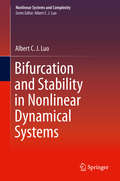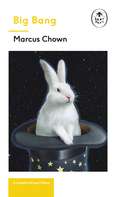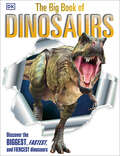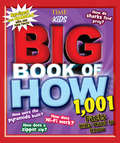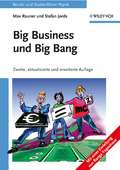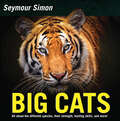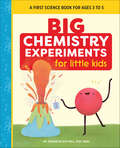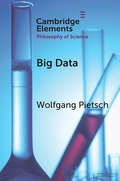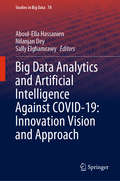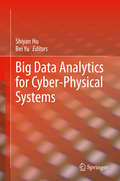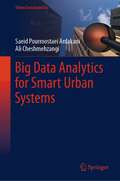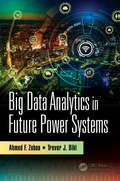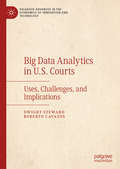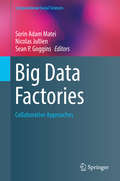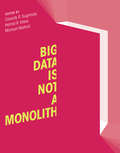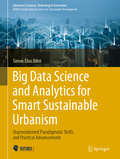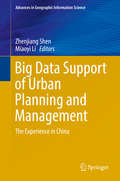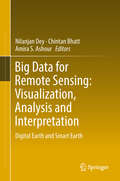- Table View
- List View
Bifurcation and Stability in Nonlinear Dynamical Systems (Nonlinear Systems and Complexity #28)
by Albert C. LuoThis book systematically presents a fundamental theory for the local analysis of bifurcation and stability of equilibriums in nonlinear dynamical systems. Until now, one does not have any efficient way to investigate stability and bifurcation of dynamical systems with higher-order singularity equilibriums. For instance, infinite-equilibrium dynamical systems have higher-order singularity, which dramatically changes dynamical behaviors and possesses the similar characteristics of discontinuous dynamical systems. The stability and bifurcation of equilibriums on the specific eigenvector are presented, and the spiral stability and Hopf bifurcation of equilibriums in nonlinear systems are presented through the Fourier series transformation. The bifurcation and stability of higher-order singularity equilibriums are presented through the (2m)th and (2m+1)th -degree polynomial systems. From local analysis, dynamics of infinite-equilibrium systems is discussed. The research on infinite-equilibrium systems will bring us to the new era of dynamical systems and control. Presents an efficient way to investigate stability and bifurcation of dynamical systems with higher-order singularity equilibriums;Discusses dynamics of infinite-equilibrium systems;Demonstrates higher-order singularity.
Big Bang: Discover how the universe began
by Marcus ChownWhat really happened in the Big Bang? Learn from the experts in the ALL-NEW LADYBIRD EXPERT SERIESThe Big Bang is an accessible, authoritative introduction for anyone looking to understand how the universe came to be.The greatest discovery in the history of science is that the universe has not existed forever but was born. There was a day without a yesterday . . .Written by award-winning writer and former astrophysicist Marcus Chown, The Big Bang details how 13.82 billion years ago all matter, energy, space - and even time - erupted into being in a titanic fireball.This mind-bending book addresses the big questions: What was the Big Bang? What drove the Big bang? And what happened before the Big Bang?Inside you'll discover:- What Einstein missed- Why the universe is expanding- The elements that made up the Big Bang- Where the universe came from- And much more . . .The evidence for the Big Bang, it turns out, is all around us...Learn about other topics in the Ladybird Experts series including Gravity, Quantum Physics, Climate Change and Evolution.Written by the leading lights and most outstanding communicators in their fields, the Ladybird Expert books provide clear, accessible and authoritative introductions to subjects drawn from science, history and culture. For an adult readership, the Ladybird Expert series is produced in the same iconic small hardback format pioneered by the original Ladybirds. Each beautifully illustrated book features the first new illustrations produced in the original Ladybird style for nearly forty years.
Big Book of Ballistics
by Philip P. MassaroBallistics Explained. . . In Plain Language! The physics of firearms and ammunition can be difficult to understand, with numerous technical terms and definitions that warrant explanation. In Big Book of Ballistics, author and ballistics expert Philip Massaro lifts the veil. He explains interior, exterior and terminal ballistics in plain language. Massaro takes you on a journey that starts inside the cartridge case and terminates on the other side of a blasted-out target. Whether new or experienced, your knowledge of bullet performance and choice will be pushed to the absolute limit, as the world of factory and custom bullet and component choices is revealed. No dry technical manual, Big Book of Ballistics relies on Massaro's worldwide pursuit of small, medium and dangerous game adventure in heart-pounding true stories that make the science of ballistics as real as it gets. Inside the book: The terminology of ballistics in plain language How to choose the best ammunition Successful long-range shooting principles Terminal ballistics of hunting, target and self-defense bullets Illustrative charts/graphs depict comparisons between bullet shapes, trajectories and wind drift Modern developments in bullet technology can greatly enhance hunting and shooting performance. Understand the ballistic benefits with Big Book of Ballistics.
Big Book of Dinosaurs (DK Big Books)
by DKGet ready to roar with this updated edition of DK's beloved Big Book of Dinosaurs Dinosaurs fascinate young children, and this colorful catalog of those mysterious creatures from the past will keep even toddlers entertained for hours. Children will love spotting and learning to name all the different dinosaurs--from the fierce, meat-eating Tyrannosaurus and the long-necked, plant-eating Diplodocus to the armor-plated Stegosaurus and the tiny, hen-sized Compsognathus.
Big Book of How Revised and Updated (A TIME for Kids Book)
by The Editors of Time For KidsHow does a chameleon change colors? How do astronauts train for a space mission? How do diamonds form? How does Wi-Fi work?The best-selling book in TIME For Kids' Big Book of Questions series is newly revised with updated information, photos, illustrations, and graphics to answer over 500 new questions in popular subject areas: Animals, Space, History, Science, Technology, Sports and more. Presented in an easy-to-follow format, this fun, must-have reference book will appeal to a young child's sense of curiosity. Kids can dive into the book at any point and learn over 1,001 amazing facts to impress their parents, teachers, and friends with their new found knowledge.
Big Business und Big Bang: Berufs- und Studienführer Physik
by Max Rauner Stefan JordaSie wollen studieren, aber was? Physik hat schlechte Karten - ein langes, schwieriges Studium, schlechte Berufsaussichten und geringes Gehalt, denken Sie. Mit der Realität auf dem Arbeitsmarkt haben diese Vorurteile wenig zu tun: Dass Physiker nicht ständig im Labor stehen oder gerade eine geniale Idee ausbrüten, hat sich kaum herumgesprochen. Dabei arbeiten sie nach dem Studium in Banken und Versicherungen, als Forschungsmanager und Patentanwalt, in der Automobilbranche und Telekommunikation, bei Optikfirmen und Unternehmensberatungen. Von Big Business bis Big Bang gibt es kaum ein Gebiet, auf dem sie nicht vertreten sind. Diese zweite, ergänzte Auflage beinhaltet zusätzlich Medizinphysik, Chemie und die Energiebranche als Berufsportraits; darüber hinaus aktuelle Informationen über Bachelor-Master-Studiengänge sowie einen aktualisierten Serviceteil.
Big Cats: Revised Edition
by Seymour SimonIn this completely updated edition of Big Cats, award-winning writer Seymour Simon celebrates the grace and power of lions, tigers, leopards, jaguars, cheetahs, pumas, and snow leopards. Readers will learn all about how they hunt, care for their young, and rest in their varied natural habitats. This nonfiction picture book is packed with information and beautiful color photographs. Cat fans and kids ages 6 to 10 looking for facts, whether for a report or just for fun, will find much to like in Big Cats.This updated edition includes:Author’s noteStunning full-color photographsGlossaryIndexAdditional reading sourcesSupports the Common Core Learning Standards, Next Generation Science Standards, and the Science, Technology, Engineering, and Math (STEM) standards.
Big Chemistry Experiments for Little Kids: A First Science Book for Ages 3 to 5 (Big Experiments for Little Kids)
by Megan Olivia HallLearn science through play with interactive chemistry experiments for kids ages 3 to 5Little kids love to ask questions about the world around them, and the best way for them to find answers is with their own two hands! This exciting book about science for preschool and kindergarten kids features 20 quick and easy chemistry projects that your little learner will want to try again and again.Science for kids—Kids can create slippery slime, draw a picture with invisible ink, and make a rain cloud in a cup, all with easy-to-find household materials.Simple steps—These experiments are easy enough for young children to do with just a little help, and most only take about 20 minutes.Explore chemistry—Each experiment illustrates a chemical reaction—from bubbling seashells to an exploding volcano—and enhances learning with questions and explanations about each project.Encourage kids to explore why things work with a fun and simple book of science for kids.
Big Chicken: The Incredible Story of How Antibiotics Created Modern Agriculture and Changed the Way the World Eats
by Maryn MckennaIn this eye-opening exposé, acclaimed health journalist and National Geographic contributor Maryn McKenna documents how antibiotics transformed chicken from local delicacy to industrial commodity—and human health threat—uncovering the ways we can make America's favorite meat safer again. What you eat matters—for your health, for the environment, and for future generations. In this riveting investigative narrative, McKenna dives deep into the world of modern agriculture by way of chicken: from the farm where it's raised directly to your dinner table. Consumed more than any other meat in the United States, chicken is emblematic of today's mass food-processing practices and their profound influence on our lives and health. Tracing its meteoric rise from scarce treat to ubiquitous global commodity, McKenna reveals the astounding role of antibiotics in industrial farming, documenting how and why "wonder drugs" revolutionized the way the world eats—and not necessarily for the better. Rich with scientific, historical, and cultural insights, this spellbinding cautionary tale shines a light on one of America's favorite foods—and shows us the way to safer, healthier eating for ourselves and our children.
Big Chicken: The Incredible Story of How Antibiotics Created Modern Agriculture and Changed the Way the World Eats
by Maryn MckennaIn this eye-opening exposé, acclaimed health journalist and National Geographic contributor Maryn McKenna documents how antibiotics transformed chicken from local delicacy to industrial commodity—and human health threat—uncovering the ways we can make America's favorite meat safer again. What you eat matters—for your health, for the environment, and for future generations. In this riveting investigative narrative, McKenna dives deep into the world of modern agriculture by way of chicken: from the farm where it's raised directly to your dinner table. Consumed more than any other meat in the United States, chicken is emblematic of today's mass food-processing practices and their profound influence on our lives and health. Tracing its meteoric rise from scarce treat to ubiquitous global commodity, McKenna reveals the astounding role of antibiotics in industrial farming, documenting how and why "wonder drugs" revolutionized the way the world eats—and not necessarily for the better. Rich with scientific, historical, and cultural insights, this spellbinding cautionary tale shines a light on one of America's favorite foods—and shows us the way to safer, healthier eating for ourselves and our children.
Big Data (Elements in the Philosophy of Science)
by Wolfgang PietschBig Data and methods for analyzing large data sets such as machine learning have in recent times deeply transformed scientific practice in many fields. However, an epistemological study of these novel tools is still largely lacking. After a conceptual analysis of the notion of data and a brief introduction into the methodological dichotomy between inductivism and hypothetico-deductivism, several controversial theses regarding big data approaches are discussed. These include, whether correlation replaces causation, whether the end of theory is in sight and whether big data approaches constitute entirely novel scientific methodology. In this Element, I defend an inductivist view of big data research and argue that the type of induction employed by the most successful big data algorithms is variational induction in the tradition of Mill's methods. Based on this insight, the before-mentioned epistemological issues can be systematically addressed.
Big Data Analysis for Bioinformatics and Biomedical Discoveries (Chapman & Hall/CRC Computational Biology Series)
by Shui Qing YeDemystifies Biomedical and Biological Big Data AnalysesBig Data Analysis for Bioinformatics and Biomedical Discoveries provides a practical guide to the nuts and bolts of Big Data, enabling you to quickly and effectively harness the power of Big Data to make groundbreaking biological discoveries, carry out translational medical research, and implem
Big Data Analytics and Artificial Intelligence Against COVID-19: Innovation Vision and Approach (Studies in Big Data #78)
by Aboul-Ella Hassanien Nilanjan Dey Sally ElghamrawyThis book includes research articles and expository papers on the applications of artificial intelligence and big data analytics to battle the pandemic. In the context of COVID-19, this book focuses on how big data analytic and artificial intelligence help fight COVID-19. The book is divided into four parts. The first part discusses the forecasting and visualization of the COVID-19 data. The second part describes applications of artificial intelligence in the COVID-19 diagnosis of chest X-Ray imaging. The third part discusses the insights of artificial intelligence to stop spread of COVID-19, while the last part presents deep learning and big data analytics which help fight the COVID-19.
Big Data Analytics and Intelligent Applications for Smart and Secure Healthcare Services (Computational and Intelligent Systems)
by Debabrata Samanta Kamal Upreti Nishant Kumar Mohammad Shabbir Alam Mohammad Shahnawaz NasirThe book provides a comprehensive discussion for utilizing computational models such as artificial neural networks, agent-based models, and decision field theory, for reliability engineering. It further presents optimization solutions for smart and secure healthcare services. The text showcases how to predict the failure and repair rates of healthcare subsystems using computational intelligence.This book: Explores how data-driven methodologies and advanced computational intelligence are revolutionizing the healthcare industry, promoting efficiency, accessibility, and sustainability Highlights the pivotal role that big data analytics plays in harnessing vast amounts of patient records, clinical information, and real-time medical data to provide timely insights for healthcare professionals and policymakers Discusses the integration of artificial intelligence and machine learning techniques in healthcare, with a focus on revolutionizing disease detection, treatment planning, and resource allocation Lays the foundation for developing sustainable healthcare systems that are adaptable to long-term challenges, such as population growth, emerging diseases, and resource constraints Covers computational intelligence techniques, like fuzzy logic, neural networks, and evolutionary computations, emphasizing their role in solving complex, data-driven healthcare problems Includes topics like data management, visualization, protection, and complex adaptive systems, as well as hybrid computational intelligence techniques for synergistic problem-solving strategies This volume will serve as an ideal text for senior undergraduates, graduate students, and academic researchers in fields including electrical engineering, electronics and communications engineering, computer engineering, and mathematics.
Big Data Analytics for Cyber-Physical Systems
by Bei Yu Shiyan HuThis book highlights research and survey articles dedicated to big data techniques for cyber-physical system (CPS), which addresses the close interactions and feedback controls between cyber components and physical components. The book first discusses some fundamental big data problems and solutions in large scale distributed CPSs. The book then addresses the design and control challenges in multiple CPS domains such as vehicular system, smart city, smart building, and digital microfluidic biochips. This book also presents the recent advances and trends in the maritime simulation system and the flood defence system.
Big Data Analytics for Smart Urban Systems (Urban Sustainability)
by Ali Cheshmehzangi Saeid Pourroostaei ArdakaniBig Data Analytics for Smart Urban Systems aims to introduce Big data solutions for urban sustainability smart applications, particularly for smart urban systems. It focuses on intelligent big data which takes the benefits of machine learning to analyse large and rapidly changing datasets in smart urban systems. The state-of-the-art Big data analytics applications are presented and discussed to highlight the feasibility of big data and machine learning solutions to enhance smart urban systems, smart operations, urban management, and urban governance. The key benefits of this book are, (1) to introduce the principles of machine learning-enabled big data analysis in smart urban systems, (2) to present the state-of-the-art data analysis solutions in smart management and operations, and (3) to understand the principles of big data analytics for smart cities and communities. Endorsements‘Over the many years of collaboration between academia and industry, we noticed the common language is ‘big data’; with that, we have developed novel ideas to bridge the gaps and help promote innovation, technologies, and science’.- Tian Tang, Independent Researcher, China ‘Big Data Analytics is a fascinating research area, particularly for cities and city transformations. This book is valuable to those who think vigorously and aim to act ahead’.- Li Xie, Independent Researcher, China‘For urban critiques, knowledge trains aspiring opportunities toward outstanding manifestations. Smartness has evolved or/ advanced rambunctious & embracing realities along (with) novel directions and nurturing integrated city knowledge’.- Aaron Golden, SELECT Consultants, UK
Big Data Analytics in Future Power Systems
by Ahmed F. Zobaa Trevor J. BihlPower systems are increasingly collecting large amounts of data due to the expansion of the Internet of Things into power grids. In a smart grids scenario, a huge number of intelligent devices will be connected with almost no human intervention characterizing a machine-to-machine scenario, which is one of the pillars of the Internet of Things. The book characterizes and evaluates how the emerging growth of data in communications networks applied to smart grids will impact the grid efficiency and reliability. Additionally, this book discusses the various security concerns that become manifest with Big Data and expanded communications in power grids. Provide a general description and definition of big data, which has been gaining significant attention in the research community. Introduces a comprehensive overview of big data optimization methods in power system. Reviews the communication devices used in critical infrastructure, especially power systems; security methods available to vet the identity of devices; and general security threats in CI networks. Presents applications in power systems, such as power flow and protection. Reviews electricity theft concerns and the wide variety of data-driven techniques and applications developed for electricity theft detection.
Big Data Analytics in Genomics
by Ka-Chun WongThis contributed volume explores the emerging intersection between big data analytics and genomics. Recent sequencing technologies have enabled high-throughput sequencing data generation for genomics resulting in several international projects which have led to massive genomic data accumulation at an unprecedented pace. To reveal novel genomic insights from this data within a reasonable time frame, traditional data analysis methods may not be sufficient or scalable, forcing the need for big data analytics to be developed for genomics. The computational methods addressed in the book are intended to tackle crucial biological questions using big data, and are appropriate for either newcomers or veterans in the field. This volume offers thirteen peer-reviewed contributions, written by international leading experts from different regions, representing Argentina, Brazil, China, France, Germany, Hong Kong, India, Japan, Spain, and the USA. In particular, the book surveys three main areas: statistical analytics, computational analytics, and cancer genome analytics. Sample topics covered include: statistical methods for integrative analysis of genomic data, computation methods for protein function prediction, and perspectives on machine learning techniques in big data mining of cancer. Self-contained and suitable for graduate students, this book is also designed for bioinformaticians, computational biologists, and researchers in communities ranging from genomics, big data, molecular genetics, data mining, biostatistics, biomedical science, cancer research, medical research, and biology to machine learning and computer science. Readers will find this volume to be an essential read for appreciating the role of big data in genomics, making this an invaluable resource for stimulating further research on the topic.
Big Data Analytics in U.S. Courts: Uses, Challenges, and Implications (Palgrave Advances in the Economics of Innovation and Technology)
by Dwight Steward Roberto CavazosThis Palgrave Pivot identifies the key legal, economic, and policy issues surrounding the allowance to use and interpret electronic data consistently and in a scientifically valid manner in U.S. courts. Evidence based on the analysis of large amounts of electronic data ("Big Data") plays an increasing role in civil court disputes, providing information that could not have been obtained from a witness stand. While Big Data evidence presents opportunities, it also presents legal and public policy challenges and concerns. How can one be sure that deviations found in Big Data fall outside the norm? If statistical analyses can be conducted and presented different ways, how can judges and juries make sense of conflicting interpretations? When does Big Data extraction stop being investigative and instead become an invasion of privacy? This book traces the history of Big Data use in U.S. courts, couples current case studies with legal challenges to explore key controversies, and suggests how courts can change the way they handle Big Data to ensure that findings are statistically significant and scientifically sound.
Big Data Factories: Collaborative Approaches (Computational Social Sciences)
by Sean P. Goggins Sorin Adam Matei Nicolas JullienThe book proposes a systematic approach to big data collection, documentation and development of analytic procedures that foster collaboration on a large scale. This approach, designated as "data factoring" emphasizes the need to think of each individual dataset developed by an individual project as part of a broader data ecosystem, easily accessible and exploitable by parties not directly involved with data collection and documentation. Furthermore, data factoring uses and encourages pre-analytic operations that add value to big data sets, especially recombining and repurposing. The book proposes a research-development agenda that can undergird an ideal data factory approach. Several programmatic chapters discuss specialized issues involved in data factoring (documentation, meta-data specification, building flexible, yet comprehensive data ontologies, usability issues involved in collaborative tools, etc. ). The book also presents case studies for data factoring and processing that can lead to building better scientific collaboration and data sharing strategies and tools. Finally, the book presents the teaching utility of data factoring and the ethical and privacy concerns related to it. Chapter 9 of this book is available open access under a CC BY 4. 0 license at link. springer. com
Big Data Is Not a Monolith (Information Policy)
by Cassidy R. Sugimoto Hamid R. Ekbia Michael MattioliPerspectives on the varied challenges posed by big data for health, science, law, commerce, and politics.Big data is ubiquitous but heterogeneous. Big data can be used to tally clicks and traffic on web pages, find patterns in stock trades, track consumer preferences, identify linguistic correlations in large corpuses of texts. This book examines big data not as an undifferentiated whole but contextually, investigating the varied challenges posed by big data for health, science, law, commerce, and politics. Taken together, the chapters reveal a complex set of problems, practices, and policies.The advent of big data methodologies has challenged the theory-driven approach to scientific knowledge in favor of a data-driven one. Social media platforms and self-tracking tools change the way we see ourselves and others. The collection of data by corporations and government threatens privacy while promoting transparency. Meanwhile, politicians, policy makers, and ethicists are ill-prepared to deal with big data's ramifications. The contributors look at big data's effect on individuals as it exerts social control through monitoring, mining, and manipulation; big data and society, examining both its empowering and its constraining effects; big data and science, considering issues of data governance, provenance, reuse, and trust; and big data and organizations, discussing data responsibility, “data harm,” and decision making.ContributorsRyan Abbott, Cristina Alaimo, Kent R. Anderson, Mark Andrejevic, Diane E. Bailey, Mike Bailey, Mark Burdon, Fred H. Cate, Jorge L. Contreras, Simon DeDeo, Hamid R. Ekbia, Allison Goodwell, Jannis Kallinikos, Inna Kouper, M. Lynne Markus, Michael Mattioli, Paul Ohm, Scott Peppet, Beth Plale, Jason Portenoy, Julie Rennecker, Katie Shilton, Dan Sholler, Cassidy R. Sugimoto, Isuru Suriarachchi, Jevin D. West
Big Data Science and Analytics for Smart Sustainable Urbanism: Unprecedented Paradigmatic Shifts and Practical Advancements (Advances in Science, Technology & Innovation)
by Simon Elias BibriWe are living at the dawn of what has been termed ‘the fourth paradigm of science,’ a scientific revolution that is marked by both the emergence of big data science and analytics, and by the increasing adoption of the underlying technologies in scientific and scholarly research practices. Everything about science development or knowledge production is fundamentally changing thanks to the ever-increasing deluge of data. This is the primary fuel of the new age, which powerful computational processes or analytics algorithms are using to generate valuable knowledge for enhanced decision-making, and deep insights pertaining to a wide variety of practical uses and applications. This book addresses the complex interplay of the scientific, technological, and social dimensions of the city, and what it entails in terms of the systemic implications for smart sustainable urbanism. In concrete terms, it explores the interdisciplinary and transdisciplinary field of smart sustainable urbanism and the unprecedented paradigmatic shifts and practical advances it is undergoing in light of big data science and analytics. This new era of science and technology embodies an unprecedentedly transformative and constitutive power—manifested not only in the form of revolutionizing science and transforming knowledge, but also in advancing social practices, producing new discourses, catalyzing major shifts, and fostering societal transitions. Of particular relevance, it is instigating a massive change in the way both smart cities and sustainable cities are studied and understood, and in how they are planned, designed, operated, managed, and governed in the face of urbanization. This relates to what has been dubbed data-driven smart sustainable urbanism, an emerging approach based on a computational understanding of city systems and processes that reduces urban life to logical and algorithmic rules and procedures, while also harnessing urban big data to provide a more holistic and integrated view or synoptic intelligence of the city. This is increasingly being directed towards improving, advancing, and maintaining the contribution of both sustainable cities and smart cities to the goals of sustainable development. This timely and multifaceted book is aimed at a broad readership. As such, it will appeal to urban scientists, data scientists, urbanists, planners, engineers, designers, policymakers, philosophers of science, and futurists, as well as all readers interested in an overview of the pivotal role of big data science and analytics in advancing every academic discipline and social practice concerned with data–intensive science and its application, particularly in relation to sustainability.
Big Data Support of Urban Planning and Management: The Experience in China (Advances in Geographic Information Science)
by Zhenjiang Shen Miaoyi LiIn the era of big data, this book explores the new challenges of urban-rural planning and management from a practical perspective based on a multidisciplinary project. Researchers as contributors to this book have accomplished their projects by using big data and relevant data mining technologies for investigating the possibilities of big data, such as that obtained through cell phones, social network systems and smart cards instead of conventional survey data for urban planning support. This book showcases active researchers who share their experiences and ideas on human mobility, accessibility and recognition of places, connectivity of transportation and urban structure in order to provide effective analytic and forecasting tools for smart city planning and design solutions in China.
Big Data for Remote Sensing: Digital Earth And Smart Earth
by Nilanjan Dey Chintan Bhatt Amira S. AshourThis book thoroughly covers the remote sensing visualization and analysis techniques based on computational imaging and vision in Earth science. Remote sensing is considered a significant information source for monitoring and mapping natural and man-made land through the development of sensor resolutions that committed different Earth observation platforms. The book includes related topics for the different systems, models, and approaches used in the visualization of remote sensing images. It offers flexible and sophisticated solutions for removing uncertainty from the satellite data. It introduces real time big data analytics to derive intelligence systems in enterprise earth science applications. Furthermore, the book integrates statistical concepts with computer-based geographic information systems (GIS). It focuses on image processing techniques for observing data together with uncertainty information raised by spectral, spatial, and positional accuracy of GPS data. The book addresses several advanced improvement models to guide the engineers in developing different remote sensing visualization and analysis schemes. Highlights on the advanced improvement models of the supervised/unsupervised classification algorithms, support vector machines, artificial neural networks, fuzzy logic, decision-making algorithms, and Time Series Model and Forecasting are addressed. This book guides engineers, designers, and researchers to exploit the intrinsic design remote sensing systems. The book gathers remarkable material from an international experts' panel to guide the readers during the development of earth big data analytics and their challenges.
